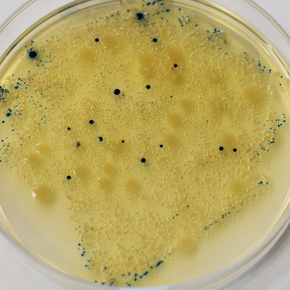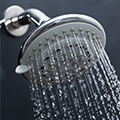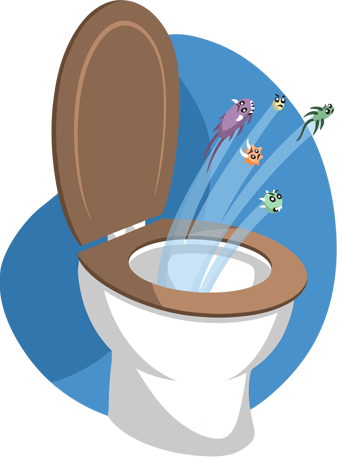The villains in the bathroom


What is a biofilm?
Like humans, bacteria are very sociable and often coalesce into clumps (attached to a surface) called biofilm. A biofilm is a slimy community of different types of bacteria and molds that live on layers of sugar and protein. An interesting fact about a biofilm is that it is a dynamic community in which bacteria protect and help each other, interact, and at some stage in the development of a biofilm, move from one site to another to develop a new biofilm, that is, to colonize new surfaces.
Their mutual communication, which takes place using small chemical molecules, is called quorum sensing. For example, bacteria from the surface layer by different signaling molecules "inform" bacteria in the deeper layers of the community, preparing them that the danger is coming, so they allow them to defend themselves against it.

The bacteria inside the biofilm are 1000 times more resistant to antibiotics and disinfectants than the bacteria outside the biofilm.


The defense mechanism in such a situation may be relocation/colonization to/of another site where bacteria develop a new biofilm, or it may involve various community modifications that ensure resistance to various hazards. These so-called “slime cities” tend to develop in humid places, and precisely the different surfaces in bathrooms, which are often covered by a thin layer of water, are the best place to make a biofilm. Therefore, to reduce the potential for infection caused by any of the bacteria present in the biofilm, it is necessary to maintain good bathroom hygiene. Regular mechanical cleaning and drying (source - author: youtube.com - Yorkshire Water) of various surfaces in the apartment, especially in the bathroom, as well as cleaning toys (source - author: youtube.com - CBS New York), can contribute to slower biofilm formation.
In aquatic systems (rivers, streams, lakes, wetlands, seas...), the most common biofilm inhabitants are the bacteria that normally live in these environments. That includes, different bacteria from the genus: , , , , , and . These bacteria are classified as a separate group of microorganisms called Opportunistic premise plumbing pathogens, that is, bacteria that, under certain conditions, have the potential to cause disease in humans. This group of microbes has some common characteristics such as the ability to form a biofilm, resistance to disinfectants, antibiotics and chlorine, and the capability to survive periods of nutrient scarcity. The aforementioned bacteria are in a specific relationship with amoebae, which may also form an integral part of the biofilm.
The Opportunistic premise plumbing pathogens can survive adverse conditions by entering into a viable but non-cultivable state (VBNC). In this state, the bacteria become "dormant" but metabolically active and cannot be cultivated under laboratory conditions. Once bacteria are found again in favorable conditions, they grow and reproduce.

Take good care of the biofilm formed on toys. Plastic toys in the bathroom are the perfect place to form a biofilm. When you spot it, you need to clean it, and to prevent the biofilm formation, you must store the toys regularly in a dry and clean place.
Communities of biofilm-forming bacteria are thousands of times more resistant to antibiotics and disinfectants than free bacteria living outside the biofilm. When in danger, cells in the biofilm begin to change rapidly to protect themselves. One of the mechanisms is that the outer layer of the biofilm becomes thicker, making the action of antibiotics or disinfectants more difficult.

The biofilm forms faster and in greater quantity on the rough surface of the limescale, which can be found on various surfaces in the bathroom, including the tap filtering nets and showerheads. Therefore, they should be cleaned regularly and, if necessary, replaced.
View more on video file.
Source - author: youtube.com - Rashmi Sheth

Growth of colonies of biofilm bacteria on irregularly cleaned tap filtering nets on a nutrient media (the bacteria that form the biofilm were removed from the net by the ultrasonic bath treatment).

Dangerous aqueous aerosol
Bioaerosol

In the atmosphere, but also everywhere around us, are tiny particles that are so small and light that they can float in the air. These particles are called aerosols. Aerosols can represent a suspension of solid particles or suspension of fluid droplets. Aqueous aerosols can be created by different devices we use daily. In our household, these are showers, taps, toilet, humidifiers and evaporators. Aerosol is also created around cooling towers, swimming pools (including spas / hot tubs) and decorative fountains. If aqueous aerosol contains microorganisms (bioaerosol), it is a source of infection for humans. Humans become infected by inhaling the aqueous aerosol that contains microorganisms. One of those microorganisms is the bacterium which is transmitted precisely by an aqueous aerosol.
If Legionella is present in water supply systems in quantities that can cause infection, during a shower we can inhale the bacteria trapped inside the tiny aerosol particles. For the Legionella to be inhaled and cause disease, the bacteria must be present in the aerosol for as long as possible. The major factor that determines how long an aerosol stays in the air is its size. Bigger aerosol has a higher deposition velocity, so the faster the aerosol is removed from the air. Therefore, only aerosol particles of a diameter <10 µm can float in the air long enough to be inhaled, and then reach the lungs and cause disease. Studies have shown that Legionella bacteria can survive in aerosols for several hours, depending on the humidity of the air and the bacteria themselves. People get Legionnaires' disease by inhaling small droplets of contaminated water (aerosols), while drinking the water is not a source of contagion. Human-to-human transmission has not been documented so far.
View more on video file.
Source - author: youtube.com - W.E.T.
It is interesting that the size of the aerosol does not depend on the flow rate of the water, but depends on its temperature. When using hot water, an aerosol of a diameter of 6.3 - 7.5 µm is created, while when using cold water the aerosols are about half the size.


If the shower is not used for a long time, let the hot water flow for a few minutes before using it. Namely, Legionella are more likely to multiply in stagnant water or on the sites where the limescale or a biofilm has been formed. Many cases of infection with this bacterium can be prevented by the proper maintenance of water supply and air conditioning systems.

Water in a toilet bowl
Every day, each household and facility uses up to 250 liters of drinking water on average. The highest consumption of drinking water is related to tooth brushing when, on average, we consume about two liters of water. The same amount of water is consumed when we wash our face. About four liters of water are required for handwashing and shaving. Although we consume about fifteen liters of water during a five-minute shower, the largest consumer of water in the bathroom, but also the entire household, is a toilet which uses more than ten liters of water per flush.
Water entering the public sewage system from a toilet bowl can contain different microorganisms that come from the human digestive system, or are the result of dumping various organic and inorganic wastes into the toilet bowl. Wastewater from the entire household - kitchen, bathroom (water generated during laundry, shower, use of toilets, etc.) enters the sewage and is drained to the wastewater treatment collectors.
These plants consist of four stages of wastewater treatment that include a preliminary, primary, secondary and tertiary treatment stage. The combination of these processes makes it possible to remove solid waste, fine inorganic particles, organic substances, microorganisms and other substances harmful to human health from the collected wastewater. Water treated in this way is called sewage treatment. The purpose of this treatment is to eliminate the above-mentioned substances and to obtain purified water of satisfactory quality, which as such can returned into nature without potentially harmful effects on the living world.
More about water treatment see on video file.
Source - author: youtube.com - Minarto Kwok

Pay attention to the things you throw in the toilet as it can have a great effect on wastewater treatment! Protect the environment and yourself by not throwing plastics, hardly degradable and hazardous chemicals, oils, paints and pesticides into the sewers!

Why is it important to put the toilet lid down?
After defecation, most people unknowingly or habitually flush the toilet without previously putting the toilet lid down. However, it should be noted that during toilet flushing, the water mixes with urine and feces, thus forming contaminated aqueous aerosol particles that fly several meters into the air and may end up on various objects in the bathroom. Contaminated particles that form during toilet flushing can transmit various bacteria and viruses that can be harmful to human health.
Therefore, before flushing the toilet it is obligatory to put the toilet lid down to prevent microorganisms from spreading on towels, tiles, toothbrushes and other accessories in the bathroom. Besides putting down the lid before flushing, it is also important to keep toothbrushes and other accessories in cabinets and protective boxes, especially for cosmetic products and towels that come in contact with your face.
View more on video file.
Source - author: youtube.com - First Class Amateur



If someone in the family is ill and has diarrhea or vomits, he or she may continue to secrete the pathogen for some time after the symptoms have stopped. Therefore, it is important to clean and disinfect the toilet bowl during and after the symptoms of a family member have stopped, to reduce the risks of other family members becoming infected.

Do you think you keep your mouth completely clean?
Do you take care of your toothbrush?

Protection from harmful bacteria on our hands
Bacteria on the hands are the largest source of a range of infectious diseases, often referred to as "dirty hands disease".
Fortunately, these diseases can be prevented by proper and regular hygiene.
When is it necessary to wash hands?
1. When you enter your home.
2. Before, during and after preparing food.
3. Before eating.
4. Before nursing a sick person.
5. Before taking a medicine.
6. Before treating open wounds.
7. After using the toilet.
8. After changing diapers or cleaning a child who used the toilet.
9. After blowing your nose, coughing or sneezing.
10. After touching animals.
11. After handling pet food.
12. After handling garbage, chemicals and unclean items.

Handwashing is a simple habit of removing impurities from the hands and reducing the number of harmful microorganisms. It is important to learn how to wash your hands properly and follow the guidelines:
•Use soap and warm water because warm water helps the soap to foam better and thus increase its activity.
•Wash hands for a minimum of 30 seconds to eliminate as many harmful bacteria as possible.
•In public places use paper towels instead of hand dryers, as microorganisms may be left behind in the hand dryers and may spread to the hands during aerial drying.
•Frequently change cotton towels in bathrooms that are meant for hand drying only. Make sure that they are not used by another person.
•Use ethyl alcohol or izopropanol based hand sanitizer. To make the sanitizer effective, it should be rubbed into the skin for about 30 seconds until the skin has dried. These sanitizers are used after standard handwashing when prolonged antimicrobial activity is desired or when we are not able to wash our hands.
Imprint of the child's hand after playing: unwashed hands
After washing in cold water without soap
After washing in cold water with soap
After brief washing in warm water with soap
After proper washing in warm water with soap

















